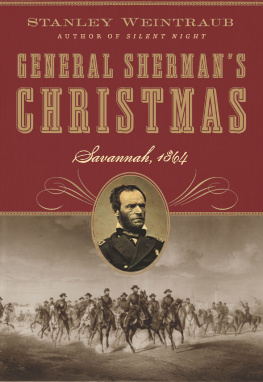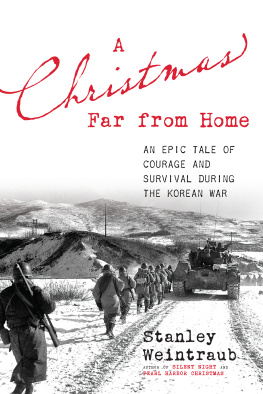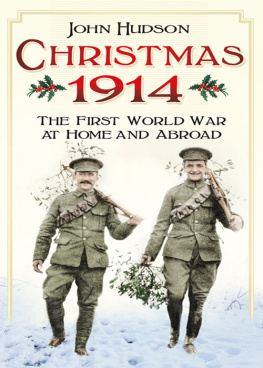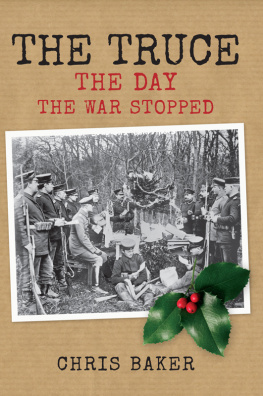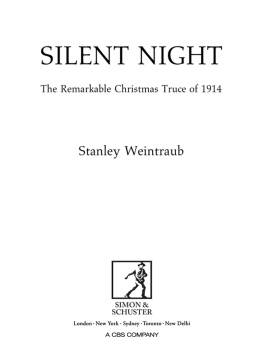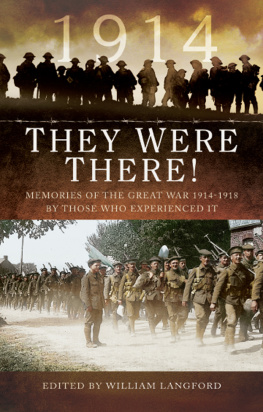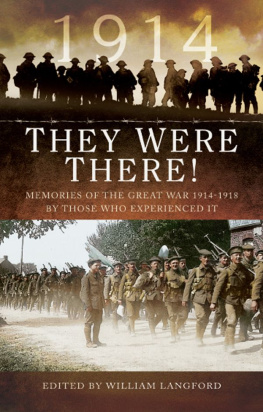SILENT NIGHT
The Story of the World War I Christmas Truce
Stanley Weintraub
Karolina Harris
THE FREE PRESS
New York London Toronto Sydney Tokyo Singapore
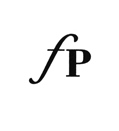
ALSO BY S TANLEY W EINTRAUB
A Stillness Heard Round the World: The End of the Great War
Long Days Journey into War: December 7, 1941
The Last Great Victory: The End of World War II
MacArthurs War: Korea and the Undoing of an American Hero

THE FREE PRESS
A Division of Simon & Schuster, Inc.
1230 Avenue of the Americas
New York, NY 10020
www.SimonandSchuster.com
Copyright 2001 by Stanley Weintraub
All rights reserved, including the right of reproduction in whole or in part in any form.
T HE F REE P RESS and colophon are trademarks of Simon & Schuster, Inc.
Designed by Karolina Harris
Manufactured in the United States of America
10 9 8 7 6 5 4 3 2
Library of Congress Cataloging-in-Publication Data
Weintraub, Stanley.
Silent Night : the story of the World War I Christmas truce / Stanley Weintraub.
p. cm.
Includes bibliographical references and index.
1. Christmas Truce, 1914. I. Title.
D530.W45 2001
940.4144dc21 20011033423
ISBN 0-684-87281-1
ISBN: 978-0-684-87281-0
eISBN: 978-1-439-10713-3
For Robert C. Doyle and Beate Engel-Doyle
P EACE IS HARDER TO MAKE THAN WAR . A Stillness Heard Round the World: The End of the Great War
(Stanley Weintraub, 1985)
Contents

Introduction
Three myths would arise during the early months of the Great War. Burly Cossacks, sent by the Czar to bolster the Western Front, were seen embarking from British railway stations for Dover, still shaking the persistent snows of Russia from their boots. In France, during the British retreat from Mons, angels appearedspirit bowmen out of the English pastto cover the withdrawal. And the third was that, to the dismay of the generals, along the front lines late in December 1914, opponents in the West laid down their arms and celebrated Christmas together in a spontaneous gesture of peace on earth and good will toward men. Only one of the mythsthe lastwas true.
In an issue sent to press just before Christmas, The New Republic, an American weekly writing from a plague-on-both-sides neutrality, accepted what seemed obvious. If men must hate, it is perhaps just as well that they make no Christmas truce. A futile resolution had been introduced in the Senate in Washington urging that the belligerents hold a twenty-day truce at Christmas with the hope that the cessation of hostilities at the said time may stimulate reflection upon the part of the nations [at war] as to the meaning and spirit of Christmas time.
Since early August the European war had claimed hundreds of thousands of killed, wounded, and missing. An appeal for a cease-fire at Christmas from Pope Benedict XV, elected just three months earlier, only weeks after war had broken out, had made headlines but was quickly rebuffed by both sides as impossible. Rather, The New Republic suggested sardonically, The stench of battle should rise above the churches where they preach good-will to men. A few carols, a little incense and some tinsel will heal no wounds. A wartime Christmas would be a festival so empty that it jeers at us.
To many, the end of the war and the failure of the peace would validate the Christmas cease-fire as the only meaningful episode in the apocalypse. It belied the bellicose slogans and suggested that the men fighting and often dying were, as usual, proxies for governments and issues that had little to do with their everyday lives. A candle lit in the darkness of Flanders, the truce flickered briefly and survives only in memoirs, letters, song, drama and story.
Live-and-let-live accommodations occur in all wars. Chronicles at least since Troy record cessations in fighting to bury the dead, to pray to the gods, to negotiate a peace, to assuage war weariness, to offer signs of amity to enemies so long opposite in a static war as to encourage mutual respect. None had ever occurred on the scale of, or with the duration, or with the potential for changing things, as when the shooting suddenly stopped on Christmas Eve, 1914. The difference in 1914 was its potential to become more than a temporary respite. The event appears in retrospect somehow unreal, incredible in its intensity and extent, seemingly impossible to have happened without consequences for the outcome of the war. Like a dream, when it was over, men wondered at it, then went on with the grim business at hand. Under the rigid discipline of wartime command authority, that business was killing.
Dismissed in official histories as an aberration of no consequence, that remarkable moment happened. For the rival governments, for which war was politics conducted by persuasive force, it was imperative to make even temporary peace unappealing and unworkable, only an impulsive interval in a necessarily hostile and competitive world. The impromptu truce seemed dangerously akin to the populist politics of the streets, the spontaneous movements that topple tyrants and autocrats. For that reason alone, high commands could not permit it to gain any momentum to expand in time and in space, or to capture broad appeal back home. That it did not was more accident than design.
After a silent night and dayin many sectors much more than thatthe war went on. The peace seemed nearly forgotten. Yet memories of Christmas 1914 persist, and underlying them the compelling realities and the intriguing might-have-beens. What if ?
Late in December 1999 a group of nine quirky Khaki Chums crossed the English Channel to Flanders with the blatantly daft idea of commemorating the truce where it may have begun, near Ploegsteert Wood in Belgium. Wearing makeshift uniforms recalling 1914, and working in the rain and snow, they dug trenches, reinforcing them with sandbags and planks which literally disappeared into the bottomless mud. For several days they cooked their rations, reinforced their parapets, and slept soaked through to the skin. They also endured curious onlookers and enjoyed visits from the media. Before departing, the nine planted a large timber cross in the quagmire as a temporary mark of respect for the wartime dead, filled back their trenches and slogged homeward.
Months later they were astonished to learn that local villagers had treated their crude memorial with a wood preservative and set it in a concrete base. In season, now, poppies flower beneath it. Thousands of Great War monuments, some moving and others mawkish, remain in town squares and military cemeteries across Europe. The after-thought of the Khaki Chums lark in the Flanders mud is the only memorial to the Christmas Truce of 1914.
1
An Outbreak of Peace
In December 1914, on both sides of the front lines in Flanders, astride the borders of Belgium and France, soldiers of two of Queen Victorias grandsons, Kaiser Wilhelm II and George V, faced off from rows of trenches that augured a long war of attrition. Belgian and French forces were also along the line, and with the British and French were troops from India and Africa who had never seen winter snows. Opposite were not only Prussians, but Saxons and Bavarians and Westphalians who would rather have been home for the holidays. Christmas was approaching, a festive time common to all the combatants, from Russia in the East to England and France in the West. Some of its most resonant symbols were claimed by Germany, especially the Christmas tree, the


